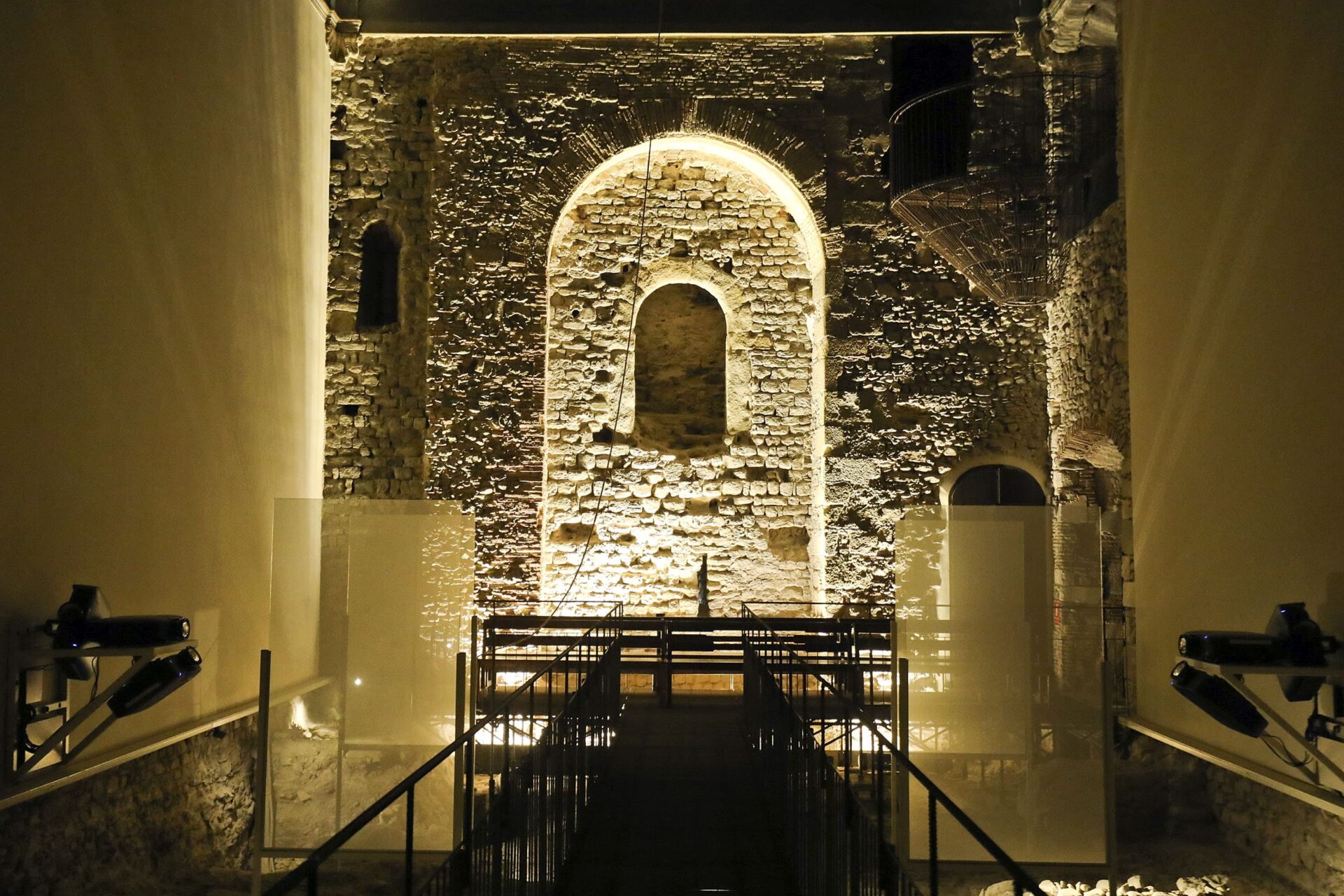ILLA DE LA PIETAT AUDIOVISUAL SHOW EXHIBITION GUIDE
VIC: A JOURNEY THROUGH TIME AND ART
We’re here…
In Vic, Osona… and at its heart:
At the highest point in the historic town centre…
Where the town began.
On just this spot all periods come together… All the stories come together in this town…
We can look for their imprint on art…
Every style gives us clues to a point in history.
Art will be our guide on this journey…
We have to travel two thousand years into the past…
AUSO, A ROMAN TRIBUTARY TOWN – CLASSICAL ART
We’re in the 1st century AD ….
Who lived in this area?
The Iberian Ausetani people had lived here for centuries.
Then came Roman civilization: merchants, soldiers and citizens who worshipped their gods.
It’s here, at the highest point, where Auso was founded.
And the temple was built right here…
It was an important city for Roman government.
One of the roads linking Gaul to Bàrcino (Barcelona) passed this way.
From its Iberian…
…and Roman past, Osona holds secrets that have survived to this day.
But very hard times lay ahead. The empire fell and the centuries passed between cultures: Carolingians, Visigoths, Saracens… they all wanted to settle here.
VIC IN THE YEAR 1000 – BETWEEN THE MONTCADAS AND BISHOP OLIBA – LOMBARD ROMANESQUE ART
We’ve reached the 9th century.
Look! It’s count Guifré [Wilfred].
He’d come down from the Pyrenees and was about to decide where to build his castle as a base to resettle the plain.
Right here.
Where the Roman temple had been… Of course…
The castle was built just where we are now.
Mediaeval Vic was a Vic with two jurisdictions.
One ruled by the count… and the other by the bishop.
The count dominated the upper part of the town and the seat of the bishop was re-established in the lower part.
And old Auso became a divided Vic:
There were ladies, knights… and the counts in the Montcada castle.
There were churchmen and canons around the bishop’s seat.
And there were tensions and conflicts between them.
From its origins and throughout its history, the bishops played a leading role in cultural life in Vic.
Figures like Gerbert d’Orlhac, the student who became pope Sylvester II, or bishop Atto and bishop Oliba were all important over these years.
The cathedral was extended and the Scriptorium set up, the origin of future higher education.
Ideas, science and art were brought into the city through the Church – and were never to leave it.
Vic became a centre of power and culture and one of the most important towns in Catalonia.
Lombard Romanesque art spread all over the county of Osona, and Old Catalonia in general.
Today we can still see the richness of mediaeval art in most of the parish churches in the area.
But also on the narrow streets of the historic town centre of Vic.
Everything grew over the centuries. And Vic gained the status of a city.
The towers and walls were to protect the castle, the cathedral and between them a large square where the market was held… a veritable symbol of the town: the Plaça del Mercadal.
And the streets were filled with artisans, merchants and also with money changers and lenders… And for almost two centuries, a small Jewish ghetto with its synagogue was even constituted.
But dark times were to come… with fights between the feudal lords.
And with the Black Death, came desolation.
THE UNIFICATION OF THE CITY – GOTHIC ART
We’re in the 15th century.
There’s a king: Alfonso IV, the Magnanimous.
He signed the charter that unified the town in a single council.
The people of Vic became a single population.
The old conflicts ended and the town’s splendour grew.
Vic rebuilt within its walls in the Gothic style.
The windows opened out to heaven in both church and civil architecture.
The town expanded beyond its walls.
A new bridge opened up a new entrance to the town for a century.
There are still traces of the slender shapes of Gothic architecture in the town… you just have to know where to look.
Touching heaven, we let ourselves be carried forward.
URBAN AND ECCLESIASTICAL DYNAMISM – BAROQUE ART
The change to the Baroque town began with a demolition.
We now arrive in a new era, after a Renaissance which left little behind it.
For a long time, different generations of master builders and sculptors from the Morató family of Vic, together with workshops of highly-skilled craftsmen, worked at the service of civil and religious art.
Students and artists mixed with craftsmen and merchants.
So why the demolition?
Well, in the 17th century, as part of a plan for fortifications that were never built, districts outside the walls were demolished.
Many Romanesque and Gothic buildings were lost.
But this made room for new town planning.
New convents were built around the mediaeval town centre.
The religious orders form part of the modern cultural life in Vic.
The town’s profile changed with a new road around it and the first neighbourhood laid out on a linear plan: the Eixample Morató.
This was a time of prosperity and splendour.
The marketplace remained the economic lung of the town. But now the square was gentrified.
The winter residences of the big country landowners in the area sprang up here and all over the town.
Houses to show off their wealth, and balconies from which to see and be seen in all their privilege.
Vic baroque is a distinctive style that can be found all over the town. Behind the austere façades are theatrical interiors filled with art, light and dynamism.
They symbolise a town that was growing and gaining cultural importance at regional level.
But don’t let yourself be too dazzled.
It’s time to leave the baroque and move on.
VIGATANISME, BETWEEN THE 19TH AND 20TH CENTURIES – THE CUTTING EDGE OF ART NOUVEAU.
Psst…
To understand this new stage in our journey, first we have to visit the diocesan library…
The process that began with the scriptorium carried on over time, through the Literary University of the 16th and 17th centuries and now with the Seminar and this library started by bishop Francesc de Veyan…
Generations of outstanding intellectuals, churchmen and professionals of the 19th and 20th centuries were trained among these books.
One of them was the thinker and politician Jaume Balmes…
… another was the poet Jacint Verdaguer…
Years later, the bishop and thinker Torras i Bages…
… And it was crucial for an artist of the international standing of the painter Josep Maria Sert.
Can you imagine the kind of cultural life the city has had with all these figures and many others?
The artistic boom of the late 19th and early 20th centuries put Vic at the forefront of Catalan cultural life.
Currents like Vigatanisme, the Renaixença (the revival of Catalan culture) and Art Nouveau left a splendid legacy in the town.
Society was also marked by the influence of religious institutions: students, seminarians, new congregations and so on. The portrait of an atmosphere that will identify Vic as the “city of saints”.
A whole new urban landscape of civil…
…and industrial architecture was also emerging, with two areas of growth: the leather industry and making cured meats.
VIC TODAY – VIC, TOWN OF ART
Let’s go back.
We’re here again.
In modern-day Vic…
¿Who do we find?
Artists…
Merchants…
Students…
Life!
We let ourselves be seduced by art and culture…
Vic has all the heritage to explain it…
Generating and spreading knowledge…
Promoting art…
Vic has a heart that attracts.
The square is its symbol and strength.
We can visit markets and fairs all year round.
The energy of the square extends through all the streets.
Vic means quality local shops.
Art, Culture, Life…
We’ve journeyed through the centuries in Vic.
But it’s all around us…
¿Want to go out and find it?
Let’s go out and enjoy it.
***********************


